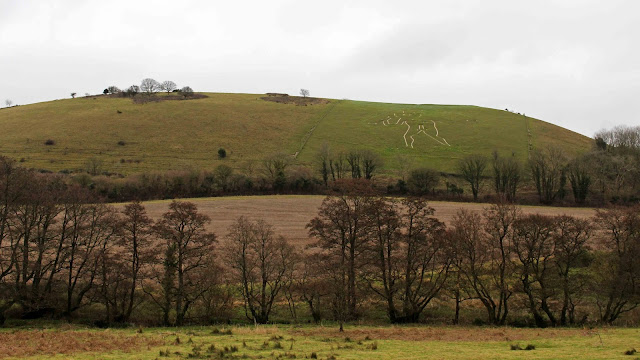You’ve got to wonder at the mind-set of
someone who creates a 180-foot-high figure of a naked, aroused man on a
hillside.
Now, you might well be thinking ‘But surely
it’s an ancient fertility symbol?” Well, the answer is that no one knows for
sure.
There is no mention of the Cerne Abbas Giant in any historic record until
an entry was made in 1694 in the church warden’s account book for St Mary’s
Church in Cerne Abbas, which states that three shillings had been paid out for ‘repairing
ye Giant’.
As the figure’s outline is actually formed by means of a
one-foot-wide by one-foot-deep trench cut into the underlying chalk and in-filled
with more chalk, presumably the three shillings was for re-chalking.
Of course, though almost certainly not
ancient, it could still be a depiction of a fertility symbol but what, then, is
the reason for the 120-foot-high club?
Interestingly, it is that very weapon
that has led to speculation that the figure is, in fact, the Roman hero Hercules,
who was often depicted naked, wielding a club in his right hand. As well as the club,
scientific tests have revealed that the Giant used to have something draped
over his left arm, though this chalk trench has since been grassed over. You
may recall that the first labour of Hercules was to kill the lion that was
terrorising the countryside around Nemea so Hercules
was traditionally portrayed with the skin of the Nemean lion draped over his
left shoulder.
(The image at right, showing the layout of the Cerne Abbas
Giant with the obliterated line [in yellow], was created by Angelus, and was sourced via
Wikimedia Commons.)
So, the Cerne Abbas Giant may well depict
Hercules but the next question, naturally enough, is who decided to carve his
outline on the hillside? Again, no one knows for sure.
One theory is that it was the work of the
monks of the Benedictine Abbey at Cerne – a strange thing for monks to do, you
might well think, but there is also a gigantic figure on the hillside close to
the former Benedictine Priory at Wilmington in Sussex (you can see more about
the Long Man of Wilmington in an earlier blog post).
The truth is that, unless some previously
unknown historic record comes to light or some archaeological evidence is
unearthed, we will never know who created the Giant or why. And I think I
prefer it that way. Let him keep his mystery!




No comments:
Post a Comment